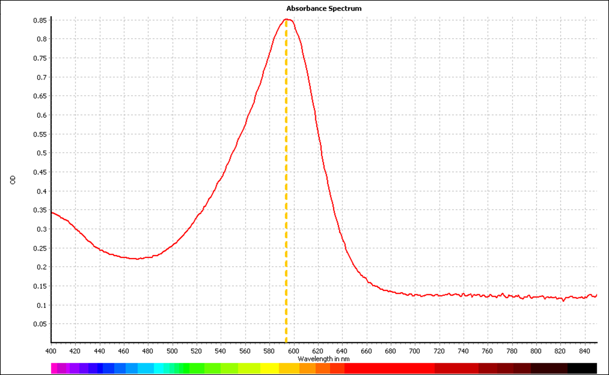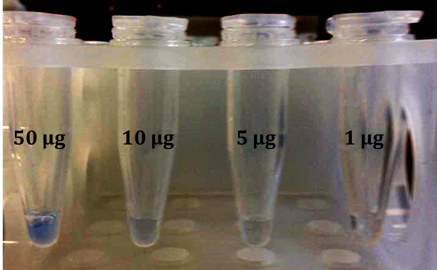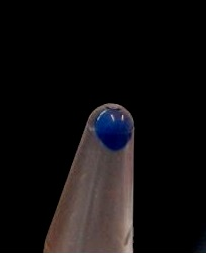Difference between revisions of "Part:BBa K1073020"
(→Usage and Biology) |
|||
| (16 intermediate revisions by 3 users not shown) | |||
| Line 2: | Line 2: | ||
<partinfo>BBa_K1073020 short</partinfo> | <partinfo>BBa_K1073020 short</partinfo> | ||
| − | + | This device is an enhanced construct of 2012 Uppsala's <partinfo>BBa_K864401</partinfo>. It consists of a strong promoter (<partinfo>BBa_J23100</partinfo>) combined with a RBS (<partinfo>BBa_B0032</partinfo>) and the encoding region of the chromoprotein aeBlue (<partinfo>BBa_K864401</partinfo>). This results in a constitutively high expression of aeBlue. | |
===Usage and Biology=== | ===Usage and Biology=== | ||
| − | During cultivation the chromoprotein aeBlue is expressed and stored | + | During cultivation, the chromoprotein aeBlue is expressed and stored intracellularly. The blue color of the protein can be seen by the naked eye, thus the chromoprotein can be used as a reporter to distinguish cells easily. |
[[Image:Expressed chromoproteins.png|450px]] | [[Image:Expressed chromoproteins.png|450px]] | ||
| − | [[Image:aeBlue_pellet.png| | + | [[Image:aeBlue_pellet.png|240px]] |
'''iGEM Team Braunschweig 2013:''' | '''iGEM Team Braunschweig 2013:''' | ||
| Line 17: | Line 17: | ||
'''Right:''' Cell pellet of ''E. coli XL1'' expressing aeBlue. | '''Right:''' Cell pellet of ''E. coli XL1'' expressing aeBlue. | ||
| + | == Exeter iGEM 2015: == | ||
| + | |||
| + | As a part of our project, three chromoproteins <partinfo>BBa_K1431814</partinfo>, <partinfo>BBa_K1073022</partinfo>, and <partinfo>BBa_K1073020</partinfo> were characterised as they could be used as potential indicators in our cell-free diagnostic test. | ||
| + | |||
| + | AeBlue was further characterised in three main ways; an absorbance spectrum was recorded, a standard curve of protein concentration vs. OD<sub>458</sub> was calculated, and a visual limit was determined. | ||
| + | |||
| + | <b>Absorbance spectrum:</b> | ||
| + | Below is an absorbance spectrum for aeBlue between 400nm and 850nm. Peak maxima is seen around 595nm. | ||
| + | |||
| + | <center>https://static.igem.org/mediawiki/2015/4/4b/Exeter_aeBlue_spectrum.png</center> | ||
| + | |||
| + | <b>Standard curve - protein concentration vs. OD:</b> | ||
| + | Below is a standard curve for concentration of protein vs. OD (595 nm). This curve can be used to determine the concentration of aeBlue based on its optical density (OD). | ||
| + | |||
| + | <center>https://static.igem.org/mediawiki/2015/a/a0/Exeter_aeBlue_standard_curve.png</center> | ||
| + | |||
| + | <b>Visual limit:</b> | ||
| + | Below is an image showing the intensity of colour at a specific amount of chromoprotein, from not visible to readily visible. The point of this characterisation is so that the level of protein expression/production required before a visual output in observed can be deduced. | ||
| + | |||
| + | <center>https://static.igem.org/mediawiki/2015/1/18/Exeter_aeBlue_visual_limit.png</center> | ||
<!-- --> | <!-- --> | ||
Latest revision as of 01:24, 19 September 2015
Constitutively expressed chromoprotein aeBlue
This device is an enhanced construct of 2012 Uppsala's BBa_K864401. It consists of a strong promoter (BBa_J23100) combined with a RBS (BBa_B0032) and the encoding region of the chromoprotein aeBlue (BBa_K864401). This results in a constitutively high expression of aeBlue.
Usage and Biology
During cultivation, the chromoprotein aeBlue is expressed and stored intracellularly. The blue color of the protein can be seen by the naked eye, thus the chromoprotein can be used as a reporter to distinguish cells easily.
iGEM Team Braunschweig 2013:
Left: Liquid cultures of E. coli XL1 expressing chromoproteins amilGFP (BBa_K1073024), eforRed (BBa_K1073022) and aeBlue.
Right: Cell pellet of E. coli XL1 expressing aeBlue.
Exeter iGEM 2015:
As a part of our project, three chromoproteins BBa_K1431814, BBa_K1073022, and BBa_K1073020 were characterised as they could be used as potential indicators in our cell-free diagnostic test.
AeBlue was further characterised in three main ways; an absorbance spectrum was recorded, a standard curve of protein concentration vs. OD458 was calculated, and a visual limit was determined.
Absorbance spectrum: Below is an absorbance spectrum for aeBlue between 400nm and 850nm. Peak maxima is seen around 595nm.

Standard curve - protein concentration vs. OD: Below is a standard curve for concentration of protein vs. OD (595 nm). This curve can be used to determine the concentration of aeBlue based on its optical density (OD).

Visual limit: Below is an image showing the intensity of colour at a specific amount of chromoprotein, from not visible to readily visible. The point of this characterisation is so that the level of protein expression/production required before a visual output in observed can be deduced.

Sequence and Features
- 10COMPATIBLE WITH RFC[10]
- 12INCOMPATIBLE WITH RFC[12]Illegal NheI site found at 7
Illegal NheI site found at 30 - 21COMPATIBLE WITH RFC[21]
- 23COMPATIBLE WITH RFC[23]
- 25COMPATIBLE WITH RFC[25]
- 1000COMPATIBLE WITH RFC[1000]


